Index


Review: Top quality, reasonable price
Today we welcome the HAF X to our lab, the new case from Cooler Master's HAF (High Air Flow) series. Cooler Master timed the HAF X really well as the HAF 932, one of the most popular cases these past couple of years, has started losing ground to newer competing high-end cases. HAF X certainly comes prepared and packs all the bells and whistles, perhaps most notably hot-swappable 3.5"/2.5" trays and USB 3.0 connectors. Just like HAF 932, HAF X comes with large silent fans.
Of course we’re talking about a full tower case with a well designed interior. Large motherboards like GA-X58A-UD9 or EVGA X58 Classified 4-Way SLI will fit like a glove, which isn’t something many cases can brag about. All this will set you back some €165, which is about what competing cases go for.
The pictures on HAF X’s box are pretty clear and show all the features of the new case. The box is sturdy and pretty easy to carry thanks to the handle. When you take into account that the case itself weighs over 14 kg, it’s definitely something you appreciate. 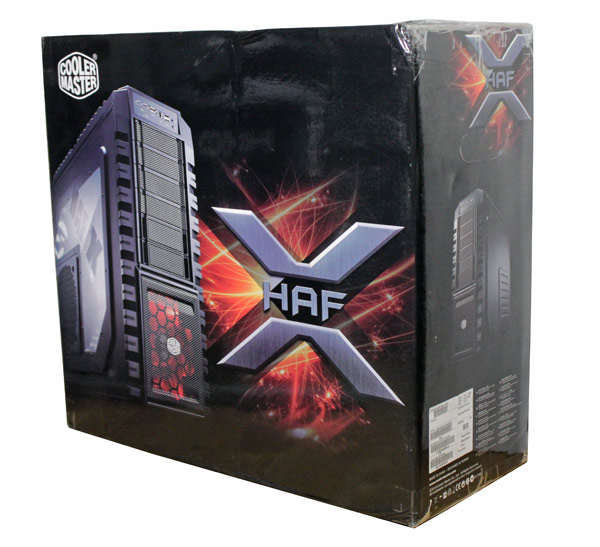
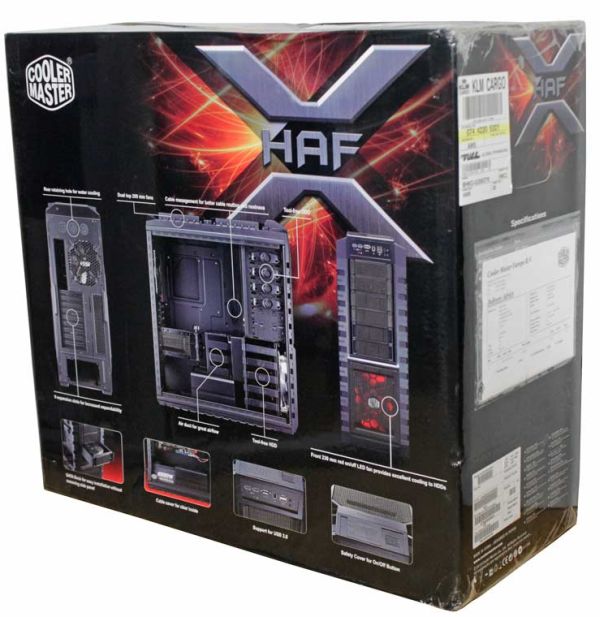

HAF X is a full tower case fully painted in black – both outside and inside. This has become a common feature with higher quality cases, especially those with side-panel windows. A lot of steel went into HAF X which results in the case weighing in at 14.35 kg (net weight). The picture below shows the HAF X right out of the box and the protective plastic still in place. 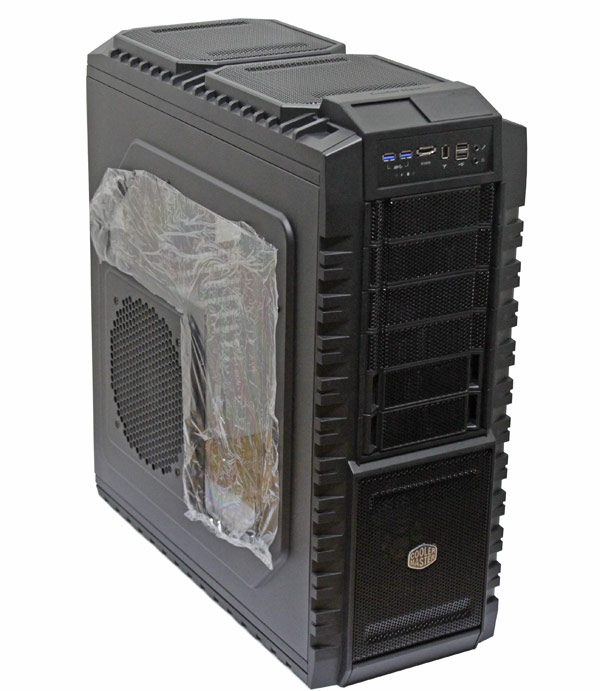
HAF series is pretty famous for its cooling, with the side-panel fan playing a major role. The fan is, as you can see, moved towards the bottom corner in order to provide room for the window. HAF X uses a 200 mm (700RPM, 19 dBA) fan, unlike the HAF 932 which comes with a 230 mm fan. 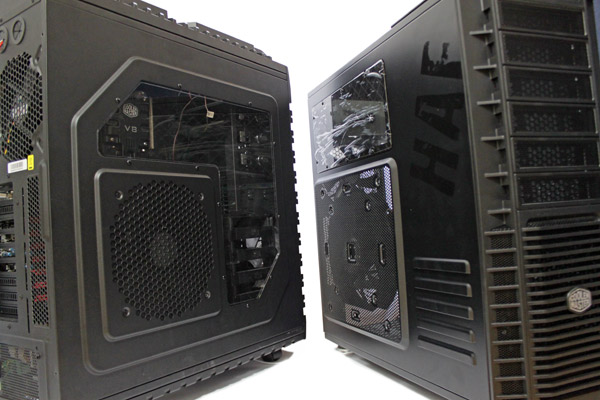
Graphics cards surely won’t mind the fan on the side panel, but that’s not all Cooler Master did to improve graphics cooling. 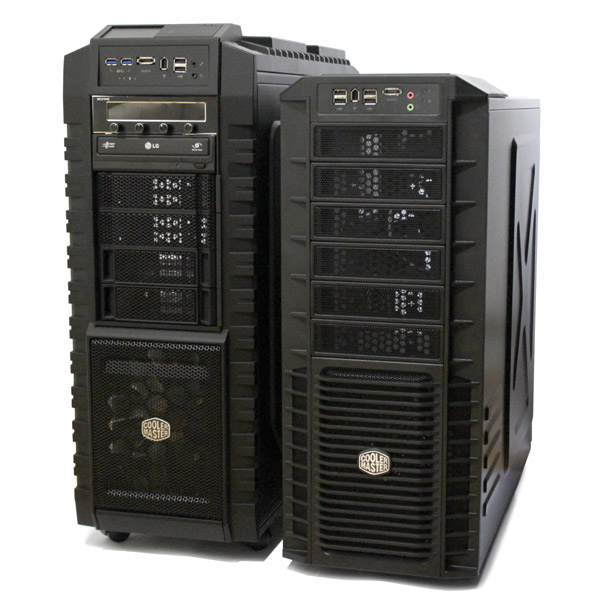
As you can see, HAF X is higher than HAF 932. HAF X is 599 mm tall (without the wheels), 253 mm wide and 554 mm long. We measured the case by hand so there’s room for error as official specs say the case measures 599/230/550 mm (H x W x L).
HAF X surely kept the toughness of its older brother; the front panel is similar at a glance, but it comes with a few important differences.
As you can see the I/O panel somewhat evolved from the HAF 932 and now we have two USB 3.0 ports.
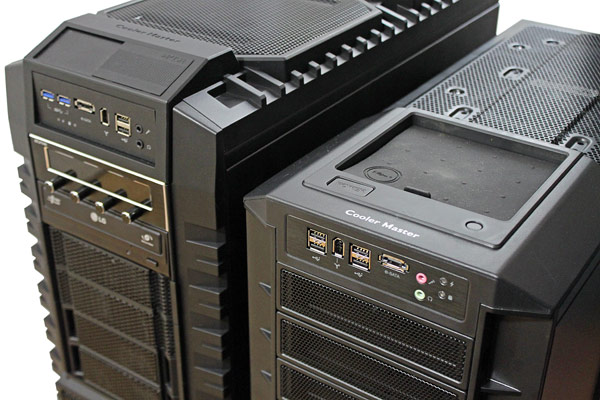
The HAF X’s control panel holds the power On/Off and reset keys, as well as the front panel fan’s LED control switch. The switches can be covered/protected by sliding a cover over them. 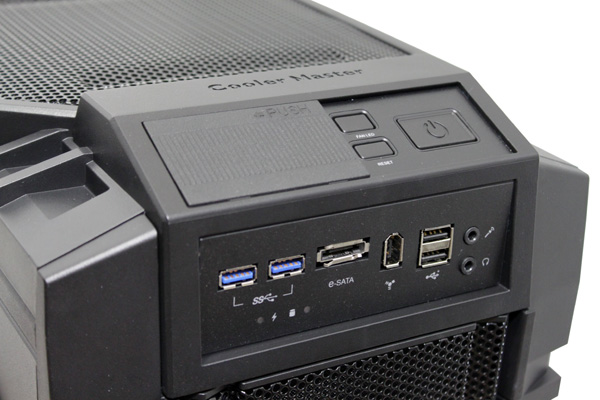
Both HAF cases feature six 5.25'' bays, but HAF X’s bottom two have been converted to SATA HDD/SSD drive bays. We’re talking about hot-swappable trays that take 3.5'' or 2.5'' drives. We’re a bit disappointed to see that HAFX doesn’t come with FDD holder, which is commonly used for card readers or fan controllers and came with HAF 932. We honestly think that €165 should buy a full case with all the accompanying accessories. 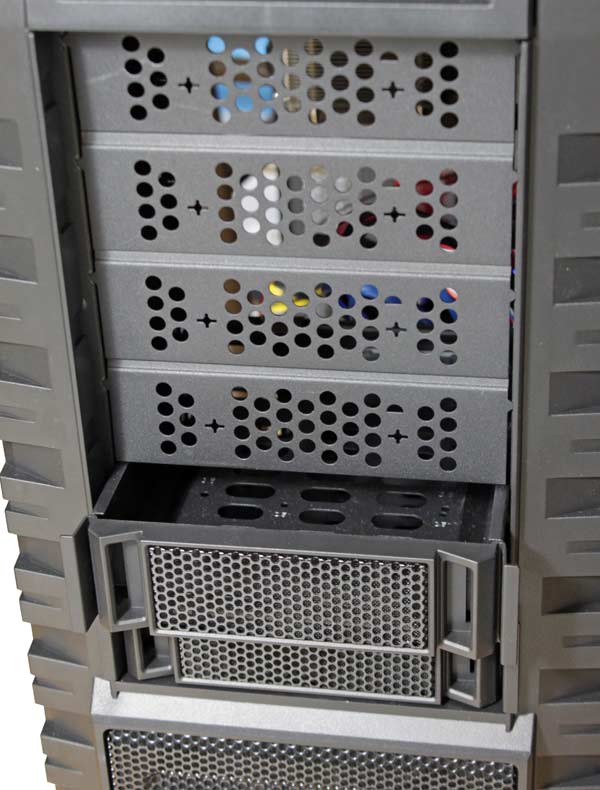
The HAF X’s top panel will take two 200 mm fans (700 RPM, 19 dBA), whereas HAF 932 (picture below, right) comes with one 230mm fan (you can replace it with three 120 mm fans or add another 120mm).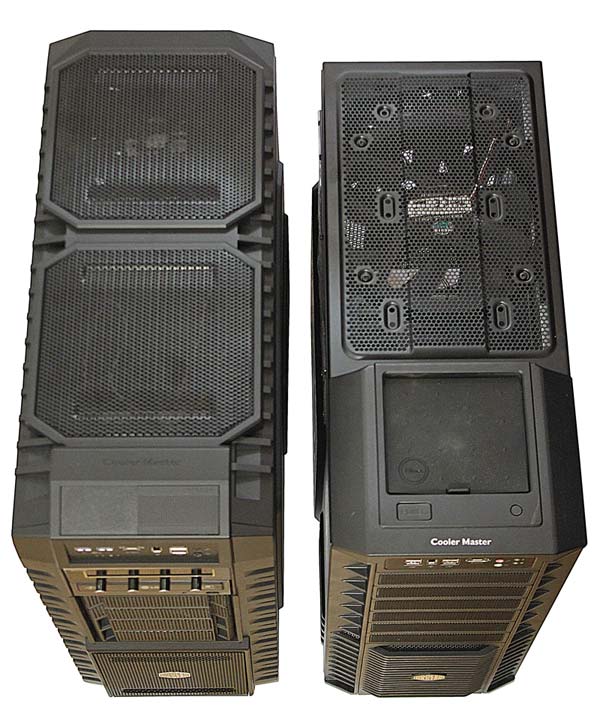
The front fan is 230 mm (700 RPM, 19 dBA) and has a LED lamp just like the HAF 932, although HAF X’s “older brother” doesn’t come with LED on/off switch.
HAF X comes with dust filters on top, side and front fans as well as on all 5.25’’ bays, but peculiarly enough, CoolerMaster decided not to include them below the PSU. 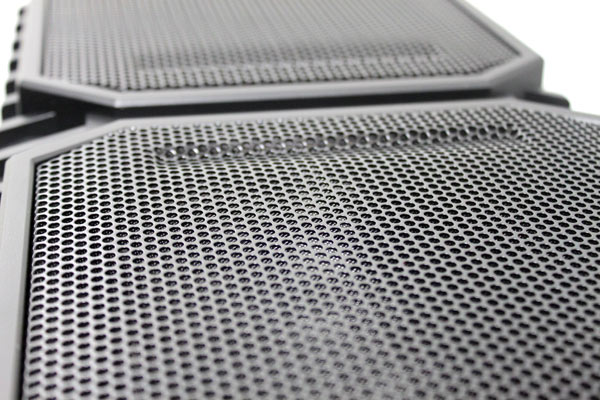
The rear panel shows the roomy insides – you can see there are 9 expansion slots, with a wire mesh for better airflow. The panel comes with a 140 mm fan (1200 RPM, 19 dBA), but you can replace it with a 120 mm one if you see fit.
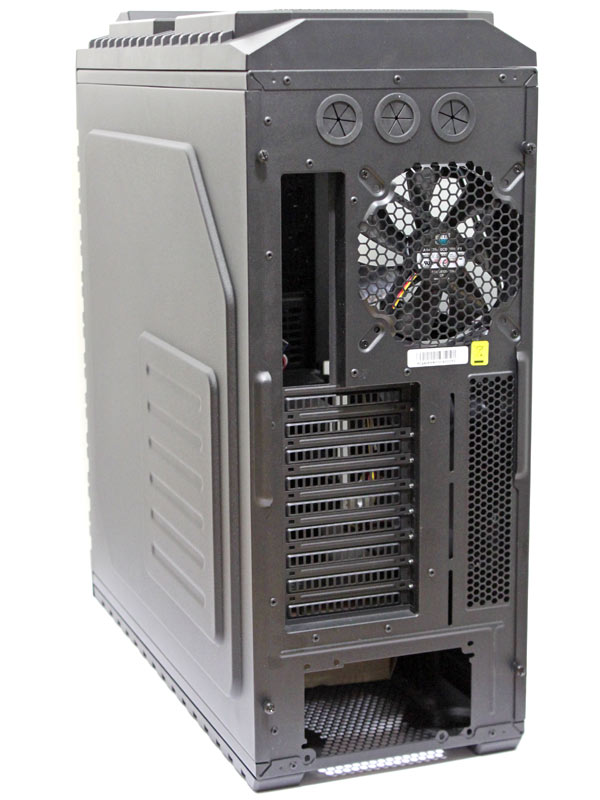
Cooler Master didn’t forget water cooling enthusiasts and the top of the case features pipe holes.
As you can see, there’s more room inside HAF X than you’d wish for.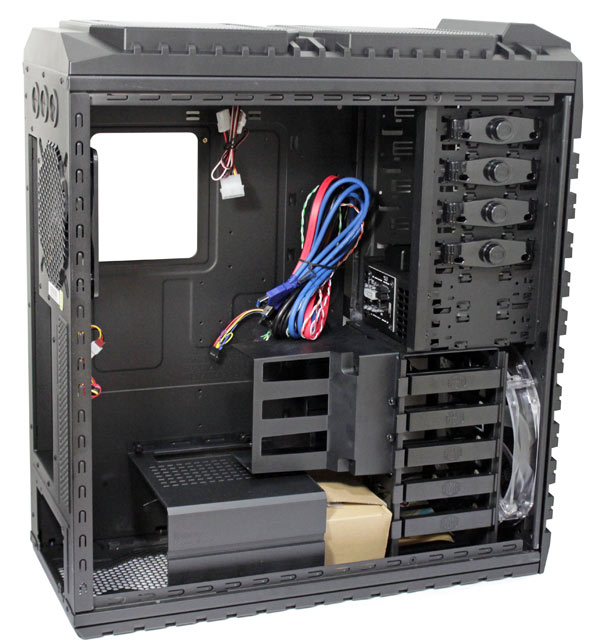
As you can see from the picture below, the air duct can hold a 120mm fan (note that the fan is not included). The same picture shows how the PSU cables are nicely hidden using the plastic cover. Note that this component is optional and can be removed at any time.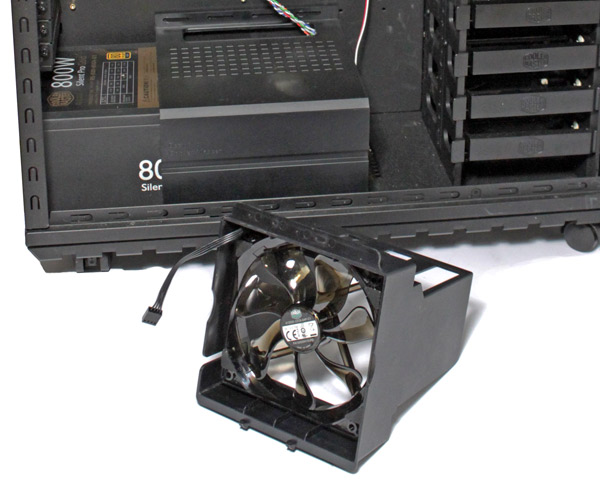
We’ve already said that HAF X’s side fan (200 mm, 700 RPM, 19 dBA) is smaller than HAF 932’s, but Cooler Master devised a plastic frame which funnels air towards the graphics card. 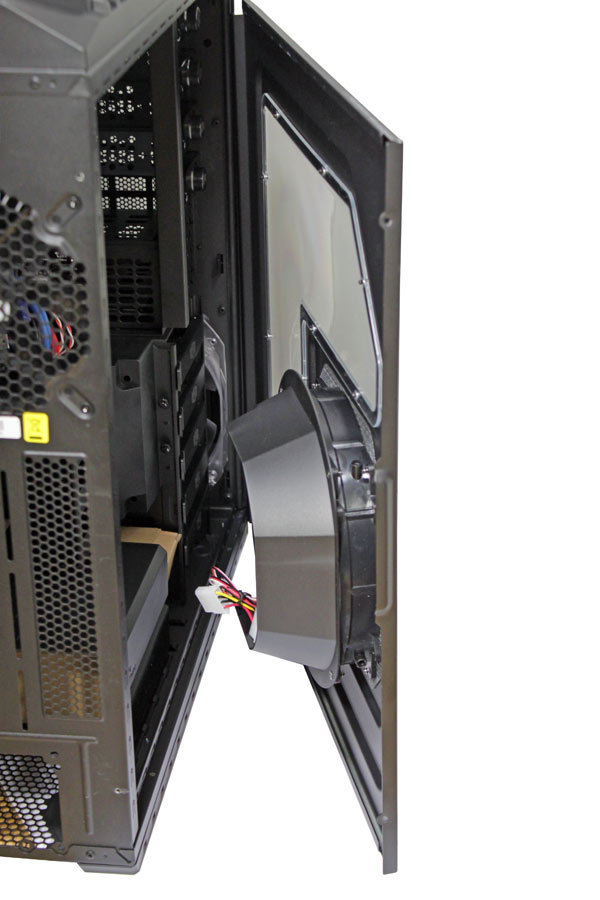
The picture below shows the difference between HAF X’s and HAF 932’s side panels.
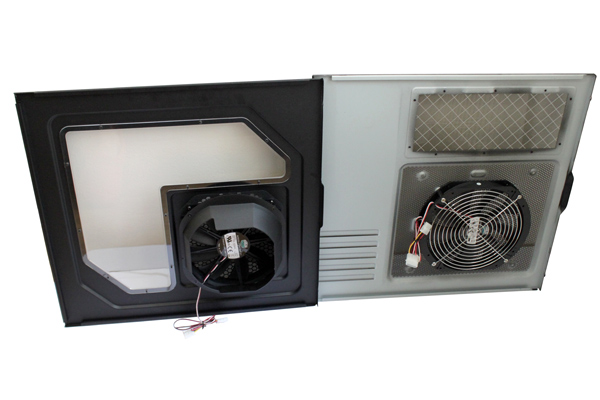
The L shaped window allows for a nice view of the HAF X’s insides.
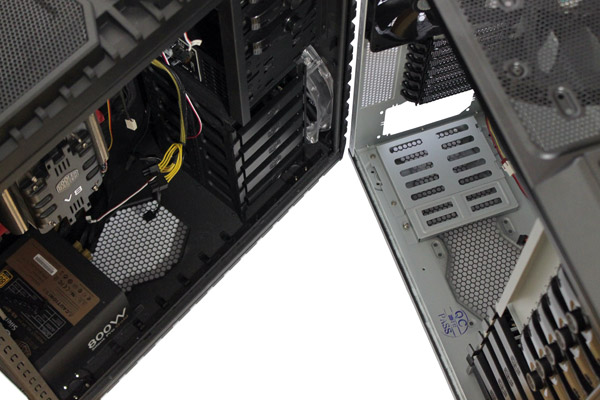
HAF X is slightly taller than the HAF 932, which will prove to be key when mounting motherboards higher than E-ATX. There's also room for a triple 120 mm-fan radiator in the roof.
Maximum supported graphics card length is 322 mm, meaning it will take pretty much any graphics card. Your CPU cooler of choice should be up to 190 mm high, and mounting it should not be a problem as the case has a hefty hole in the motherboard tray.
Of course, every high-end combination requires plenty of cables, but HAF X allows plenty of room for neat cable management as evident from the following picture. 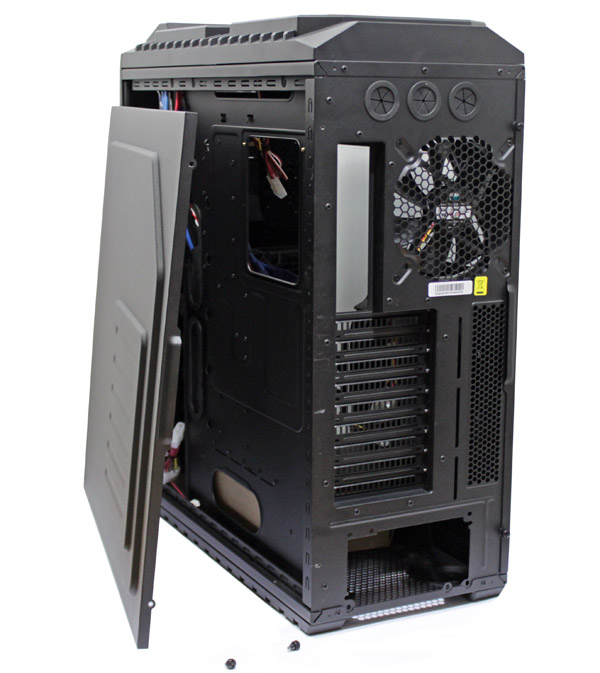
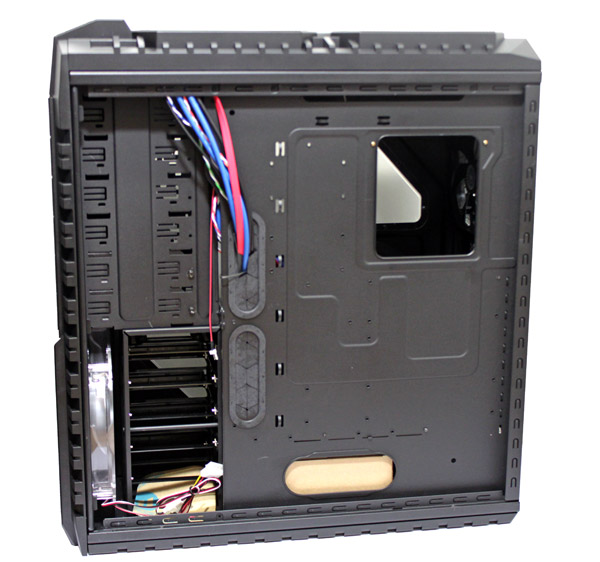
The PSU is mounted at the bottom but we found it pretty strange that there’s no dust filter here.
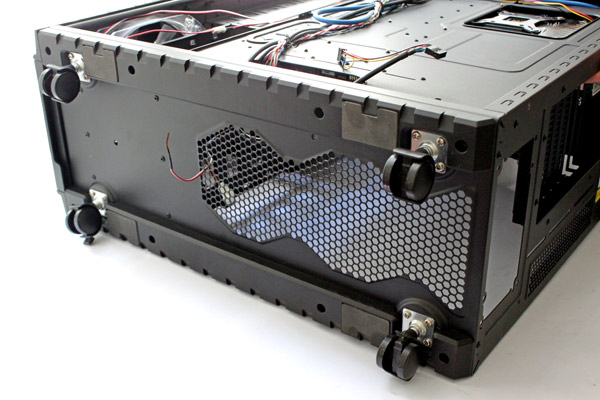
HAF X retained the HAF 932’s optical drive securing mechanism – by pushing the Cooler Master logo button, the drive will be fixed in place. 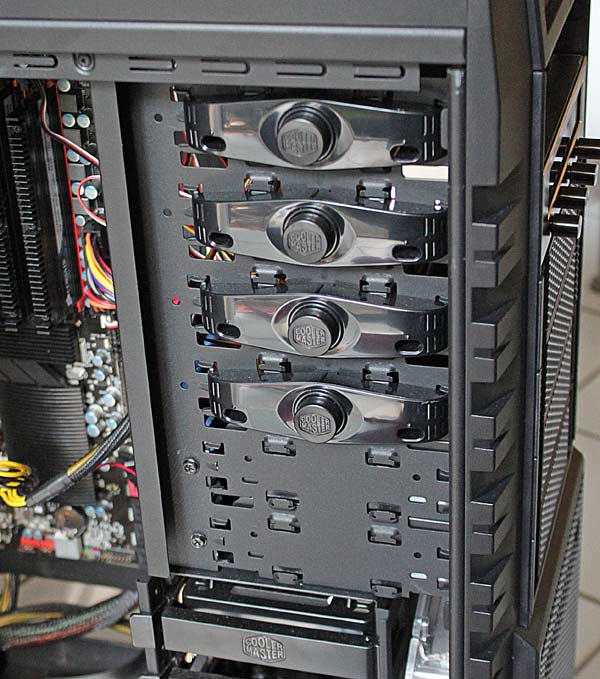
The picture balow shows the front 230 mm fan which blows air on the HDD tray. The first bay from the bottom will take two 2.5'' drives, whereas the rest will only take 3.5'' drives. The bays are removed towards the windowed side panel, which is pretty practical except for the scenarios when you have to connect/disconnect power.
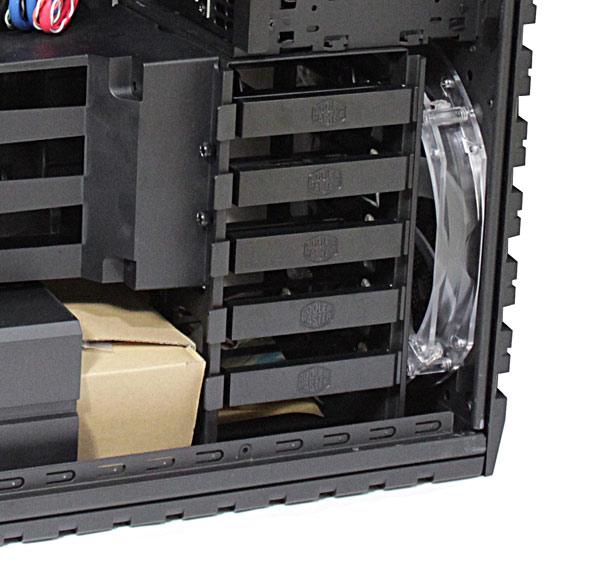
Since there's no set-in-stone method of testing cases, we thought it's best to go the practical way. We've been using our HAF X for more than a month and it's been our faithful compadre throughout other tests as well.
Will HAF X take an XL ATX motheboard?
Without blinking – in fact, HAF X is our first case that could comfortably take EVGA's x58 Classified 4-Way SLI motherboard, which is 34.5cm long.
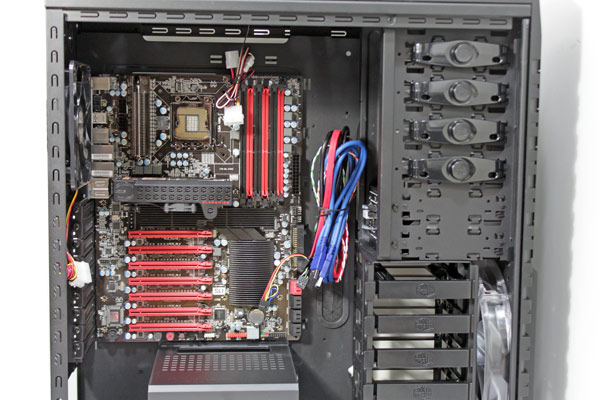
As the motherboard’s name states for itself, Classified 4-Way SLI can take up to four graphics cards. Unfortunately, if all four are dual-slot, then it won’t fit in HAF X. The reason is that the first PCI-E slot isn’t at standard distance from the CPU socket but rather positioned a bit lower, leaving the first two slots on the case unusable. The last slot on the motherboard is in line with the last slot on the case, so it will take only single slot cards. This is very important for 4-Way SLI graphics setup owners and the same goes for Gigabyte’s GA-X58A-UD9; just like EVGA’s, this motherboard requires 10 expansion slots for a 4-Way VGA system (with dual slot cards). 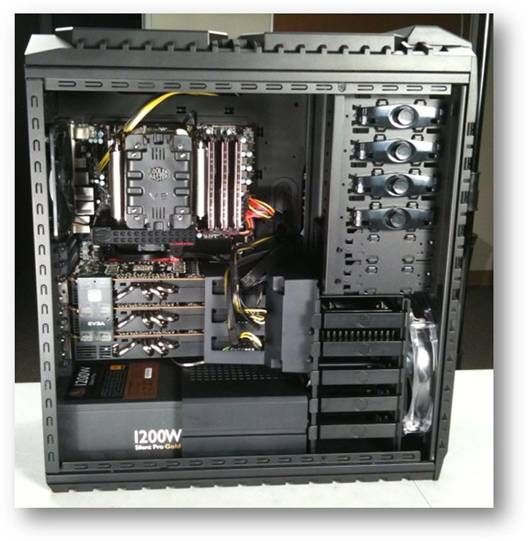
What is the maximum CPU cooler height supported?
Your CPU cooler of choice should be up to 190 mm high, and mounting it should not be a problem as the case has a hole in the motherboard tray.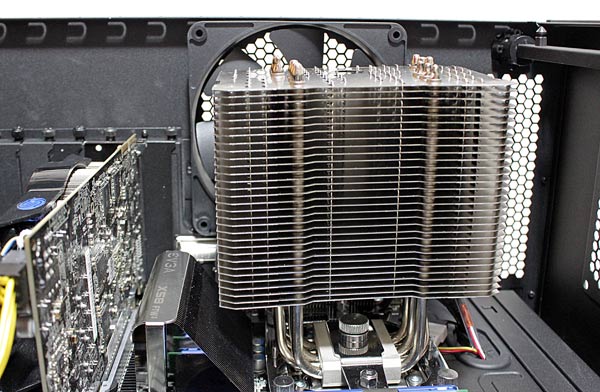
Regarding the hole in the motherboard tray behind the CPU, it was big enough for all motherboards that we have tried except for the extraordinary big EVGA 4-Way Classified, as you can see from the picture below.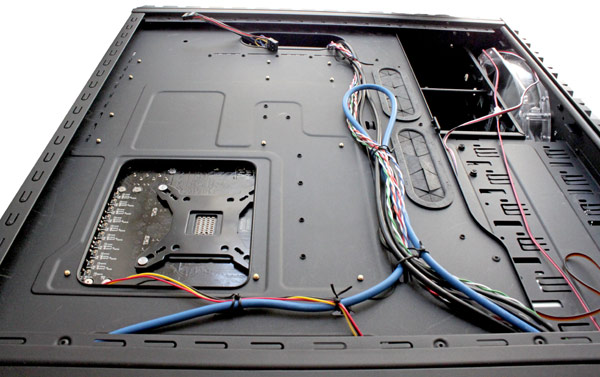
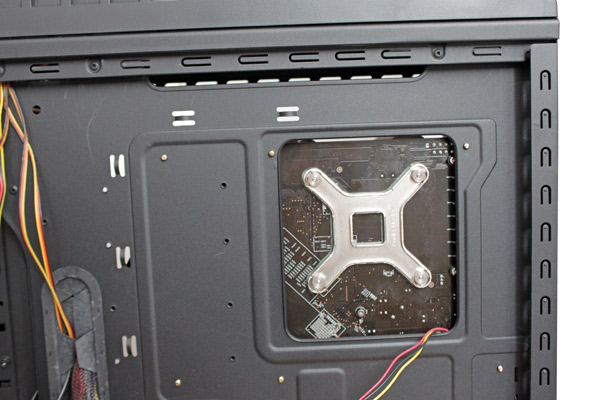
Will HAF X take currently longest graphics cards?
Without a doubt – you’ve got all the headroom you need. In fact, currently longest graphics card, the HD 5970 (picture below), will fit without problems. Video cards can be up to 322 mm. Note however that the card’s length renders the Air-Duct unusable.
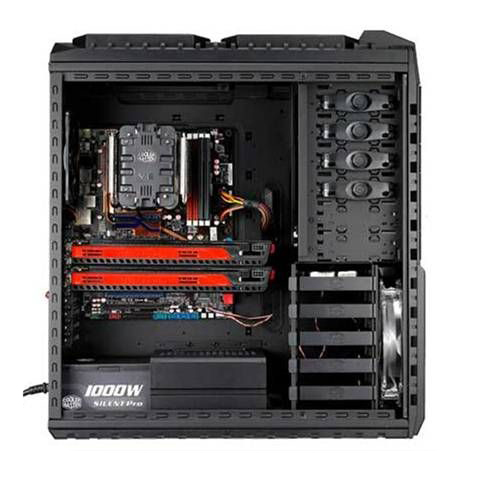
Does Air duct help with graphics card cooling?
Air duct is basically a piece of plastic with room for a 120 mm fan, which helps with cooling. On the other hand, HAF X already boasts enviable airflow, so the Air duct is probably an overkill if you’re using only one graphics card.
The holes on the side are used to route power cables, as most newer graphics cards come with power connector(s) on top, rather than at the end, which was the case with the 9800GT (picture below).
We used Gigabyte’s passively cooled Geforce 9800 GT card, where Air duct lowered idle GPU temperature from 41°C to 40°C and operating temperatures from 73°C to 70°C. We strapped our Air duct with CoolerMaster’s 120 mm A12025-22CB-6AP-C1, which ran at maximum RPM like the rest of the fans in our test.
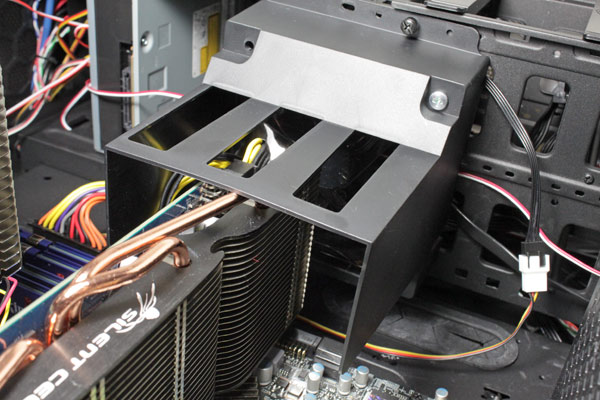
We performed the same test, but this time with a GTX 480. FurMark GPU temperatures were at 91-92°C with the Air duct, with the card’s fan running at about 3640 RPM. The temperatures remained the same after we removed the Air duct, but the card’s fan sped up to about 4440 and was much louder.
Note that the Air duct should have maximum and probably optimum impact in rigs with two or three dual slot graphics card, since such setups are usually a bit crammed and in dire need for fresh air. Such scenarios should really like the Air duct although you can’t use them with HD 5970 cards, due to the card’s length.
Does Air duct affect other components’ thermals?
The Air duct’s main task is to cool graphics cards, but it indirectly affects hard disk temperatures. Most of this is reflected on the disks in hot-swap bays, as they aren’t cooled by the front 230 mm fan.
In order for the hard disk, or an SSD drive, to be cooled by the Air duct, the latter must be positioned higher so that the air reaches the bays (like on the picture below). Thanks to the Air duct, we recorded 2°C lower temperature on the hard disk in the hot-swap bay (36°C without and 34°C with the Air duct). 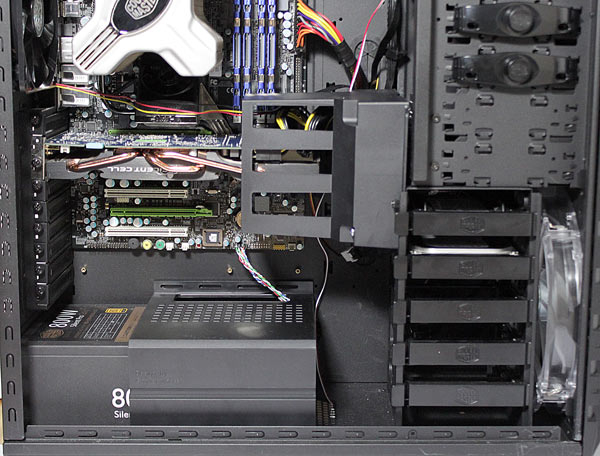
The Air duct will help with cooling hard disks in 3.5'' drive bays, but you'll have to mount it to be level with the disks.
The picture above shows the case where Air duct didn’t improve hard disk thermals; the HD was mounted in a second bay from the top, so the Air duct can’t reach it. We performed an hour of Everest’s “Stress local disks” which pushed the temperature to about 32°C. After we moved the HD one spot up, the temperature dropped to 31°C.
Will the side panel fan’s Air duct get in the way of tall VGA coolers?
The side panel fan’s Air duct is a useful addition that’s fixed to the fan via four screws – so if it bothers you, you can take it off in a minute. In most cases you won’t find it to get in the way and it will cool all reference design graphics. Furthermore, it can easily be combined with the previously discussed Air duct. The only problem you might encounter is if you’re using extremely tall non-reference coolers, such as Thermalright’s Spitfire, as the Air duct won’t let the panel back in place (picture below). 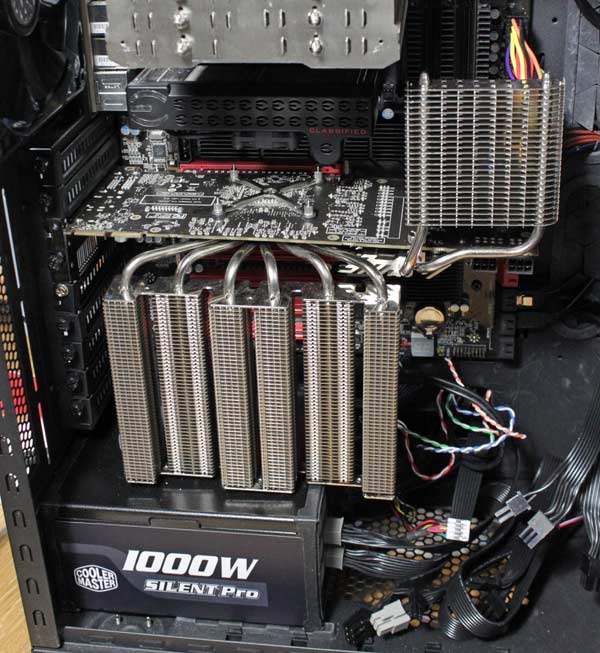
After taking the Air duct off (picture below), the “problem” was remedied. Good news for those who own or are looking to buy Thermalright’s Spitfire VGA cooler is that, thanks to HAF X’s size, the cooler can be turned downwards (like on the picture above), which means there’s no need to buy a smaller CPU cooler. Note that Spitfire is indeed huge and will fit in most cases only when turned upwards, but there’s a risk of it getting in the way of tall CPU coolers.
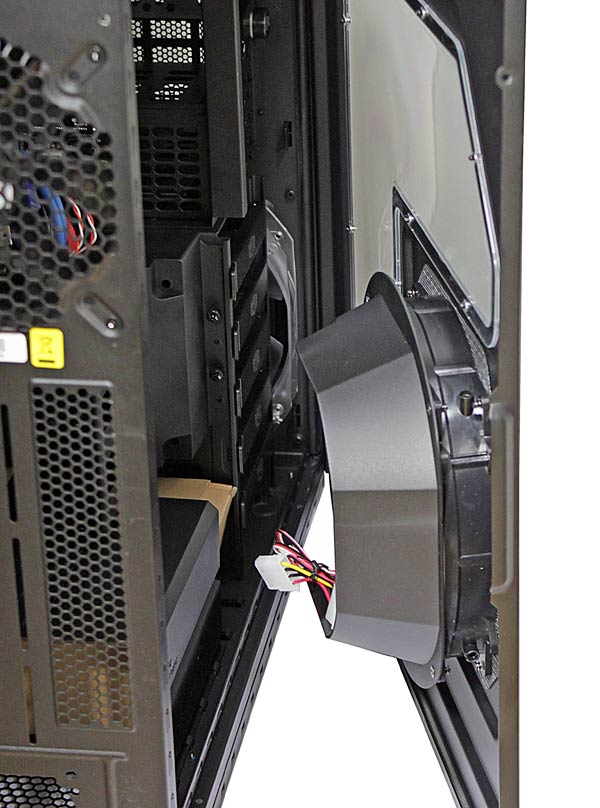
After we took the Air duct off, there was enough room for another fan on Spitfire, meaning there’s plenty of room left in the HAF X.
Will an Air duct mounted on a side-fan affect GPU temperatures?
The side fan’s Air duct comes mounted like on the picture below – with a channel on the side facing the power connectors. This is done so that PCI-E power cables can be connected to PCI-E connectors on the graphics card.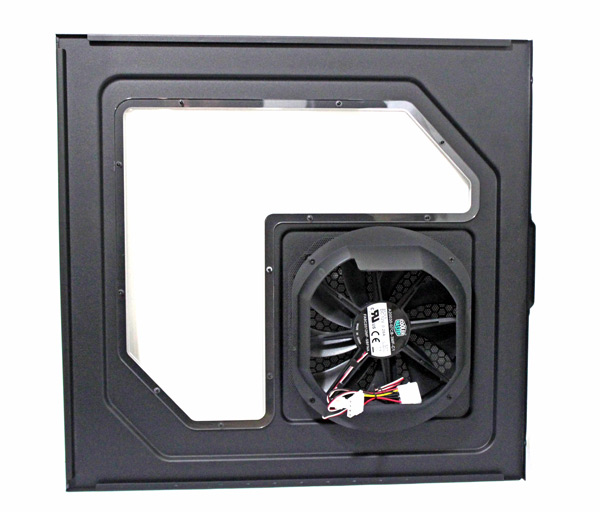
With our 9800 GT we had no worries about whether the cables are touching the Air duct as the connectors are placed at the end of the card. So, we pretty much tried every possible Air duct position to see just how it affects the CPU (Core 2 Extreme X6800 with passive cooler CM Hyper Z600) and graphics (9800 GT passive).
We made all the fans really quiet this time around – the fan in the back ran at 540 RPM, top one at 480 RPM, front fan at about 420 and the side one at 480 RPM.
The Air duct’s default setup, which is blowing air towards the end of the card, hasn’t proven to be effective with our passively cooled 9800 GT. FurMark managed to push the GPU up to 90°C whereas the CPU reached 79°C under Prime95.
We then rotated the Air duct by 180°, so that the air flows towards the case’s back panel, GPU temperatures ducked to 86°C but CPU temperatures climbed from 79°C to 81°C.
Naturally, the CPU is best cooled when the Air duct is positioned to blow directly at it. In this case, CPU temperature was at 74°C and the GPU hit 87°C.
Our passively cooled 9800 GT really liked when we pointed the Air duct downwards. GPU temperature was at 84°C but the CPU was at the hottest point in our test (82°C).
The difference between using the Air duct in its default position and using just the fan (without the duct) amounted to 3°C (on the GPU).
With all the fans running at maximum RPM and the Air duct in its default position, our 9800GT’s temperatures didn’t go over 73°C in FurMark. The same scenario saw our passively cooled Core 2 Extreme X6800 at 62°C. We compared these results to those scored by HAF 932 case, where the GPU ran at 74°C and the CPU at 59°C. We suspect that HAF 932’s bigger fans (230 mm fan on top and a 230 mm one on the side panel) are responsible for this.
Additional graphics cooling means
CoolerMaster really wanted to make sure that HAF X does anything and everything to improve graphics cooling. It’s time to talk about the VGA bracket with an 80mm fan. 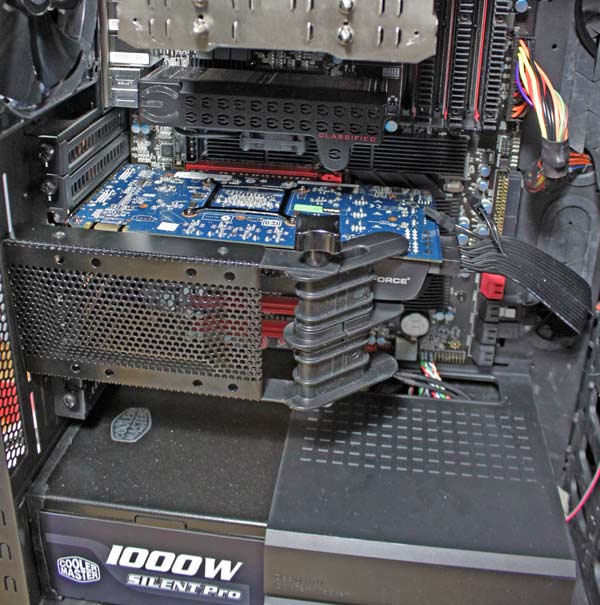
We didn’t test the VGA bracket as users get a choice of using either the Air duct or the VGA bracket on the side panel – both can’t fit at the same time.
Additionally, those who have more graphics cards will find the VGA bracket to come in handy during transport, as it lessens the strain on the PCI-E slots.
How did HAF X handle optical drive setup?
HAF X offers four 5.25'' bays. Setting them up is much easier than on other high end cases – all you need to do is pull the protective cover off and place the drive without having to remove the front panel.
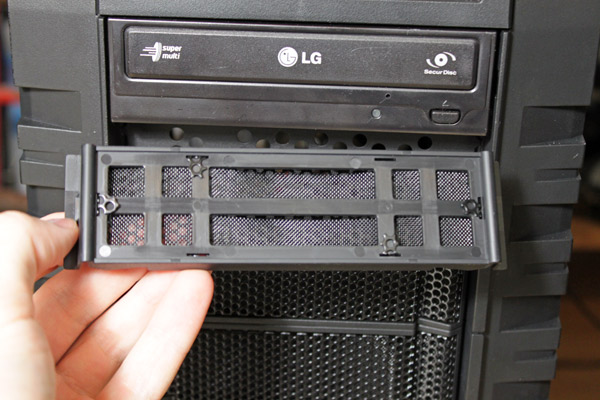
The locking system (picture below) is simple yet eficient and we've already seen on earlier CoolerMaster cases.
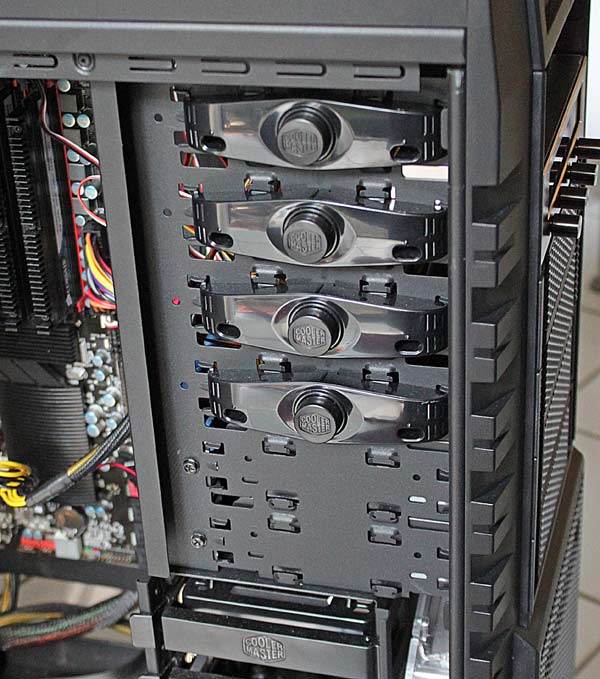
We couldn't pass up the chance to try out our Scythe KazeMaster ACE 5.25'' fan controller, which gave us much trouble in Obsidian 800D case. In normal circumstances, optical drive locking mechanism should suit Scythe 5.25'' fan controller, but Obsidian 800D's locking mechanism was placed a bit too deep. Needless to say, HAF X had no problems with this.
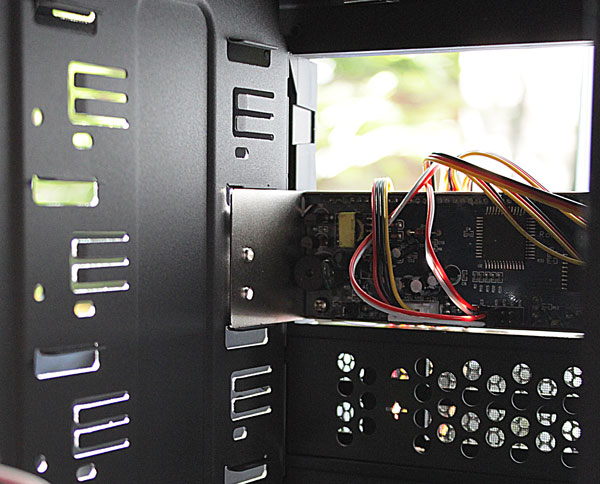
We used KazeMaster ACE 5.25'' to check the height of 5.25'' bays as this controller has been tailored to fit standard 5.25'' bays. Optical devices are not exactly 5.25’’ tall, they’re usually a tad less so you won't have problems mounting them in pretty much any case, but our testing revealed that KazeMaster ACE won't fit in all 5.25'' bays. In this case however, all four of HAF X's bays were a perfect fit.
Does an FDD bracket or 5.25''-to-2.5'' bay converter come in the box?
While the pricing would suggest so, it unfortunately isn't the case. Despite the fact that an FDD bracket is often used for card readers/fan controllers and that it has been bundled with HAF 932, CoolerMaster didn't include it this time around.
Does HAF X have hot-swap bays for 3.5'' or 2.5'' drives?
HAF X comes with two hot-swap bays for 3.5'' or 2.5'' drives, accessible via the front panel. Out of six 5.25'' bays, the bottom two can be used as hot-swap ones. The masks are pretty similar to those of 5.25'' bays, so they’ll look nice as well. 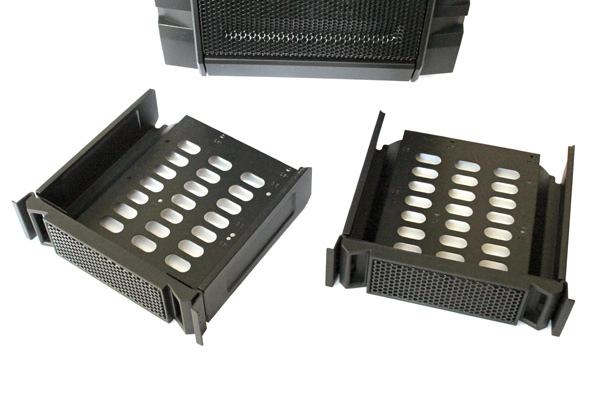
Hot swap bays are really well made and they didn’t miss the guide rails once. In comparison, this hasn’t been the case with Corsair’s Obsidian 800D, where inserting bays would sometimes result in missing the guide rails and having to try again. 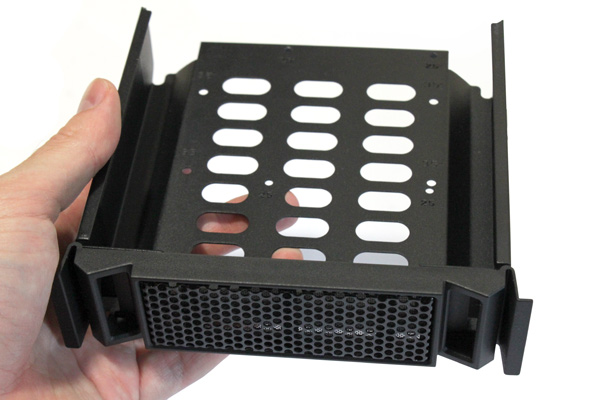
The pictures below show the hot-swap control board with the accompanying connectors. The first picture is from the front, just after we’ve taken the bays out; the second photo shows the same thing pictured from within the case.
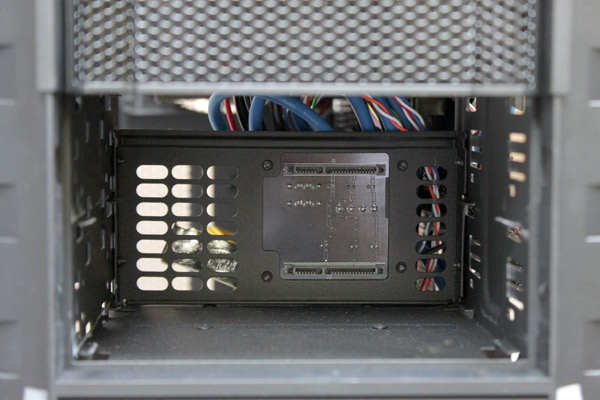
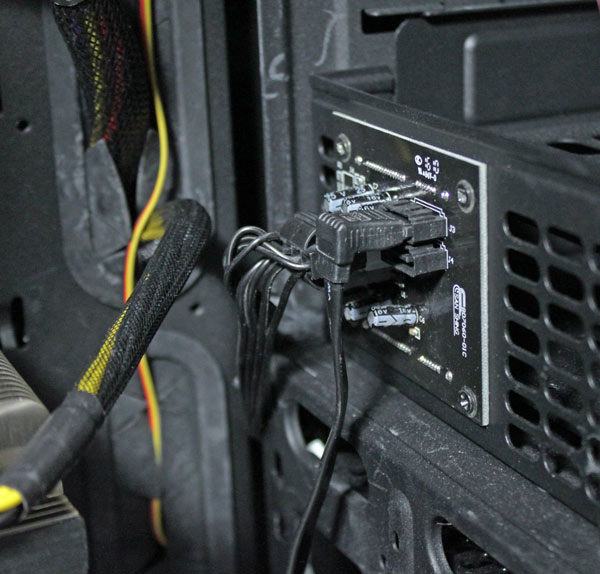
The printed board requires a 4-pin molex cable (which supplies power to both hot-swap SATA power connectors) and up to two SATA cables. We ended up using a SATA cable with an L-shaped connector, as standard connectors get in the way of the the fan if the Air duct is placed higher to cool hot-swap bays.
How many 2.5'' bays will fit into HAF X?
HAF X will take up to four 2.5'' drives. We’ve shown that two will fit into hot-swap bays whereas another two 2.5'' drives will fit into a specially designed bay within the 3.5'' drive bracket. Only one from 5 bays will take 2.5'' drives, whereas the rest is intended solely for 3.5'' ones. 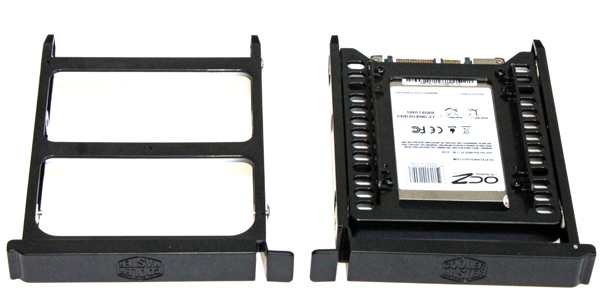
The specially designed bay will take two 2.5'' drives one below the other, so you’ll get somewhat of an SSD sandwich like on the picture below. 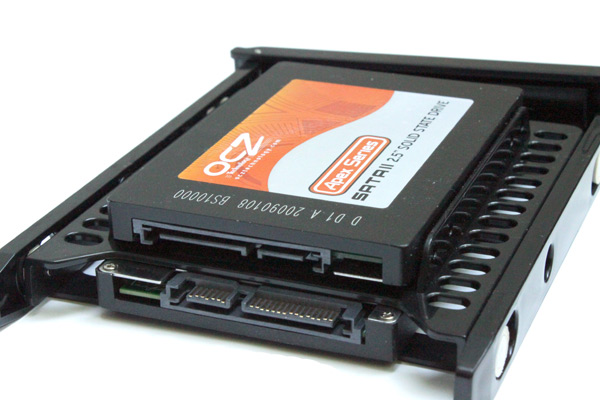
Any difficulties in mounting drives?
Although mounting SSDs or HDDs is pretty simple and straightforward, the fact that you’ll have to remove the right side panel to access cables doesn’t work in this case’s favor.
Does HAF X come with USB 3.0 connectors?
HAF X comes with two USB 3.0 connectors on the front panels, and since current motherboards come with USB 3.0 connectors on the I/O panel, the blue cable you see on the picture below is used to connect the front panel to the motherboard. One cable will take care of only one connector, so if you need two USB 3.0s – use two cables. Note that the USB 3.0 cables are long enough to reach the panel whichever way you take them.
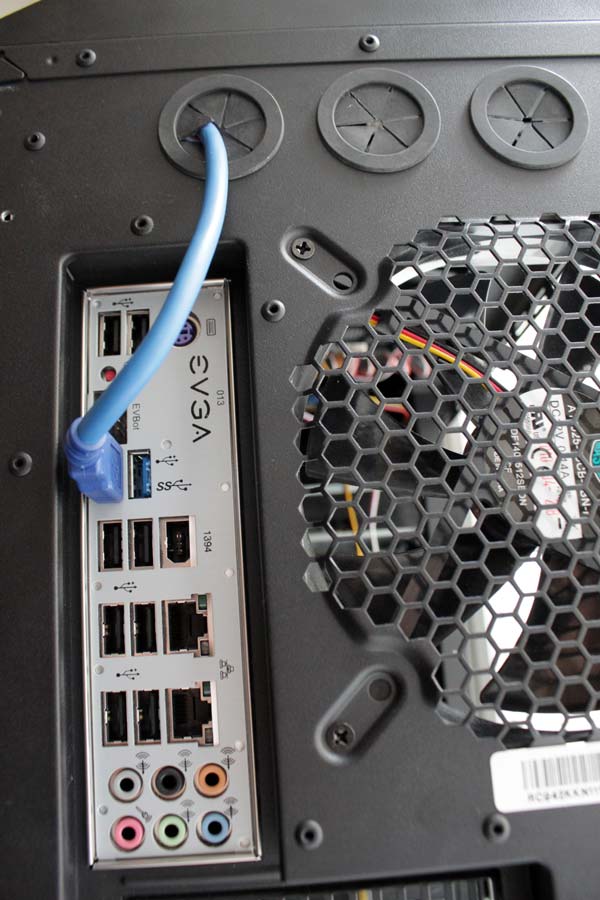
How does cable management work?
CoolerMaster obviously thought this out to a great extent. The cables can be hidden from sight and thus have a positive effect on the looks as well as airflow. There are plenty of holes in the metal to allow for easy cable routing but the case would greatly benefit from brackets to which the cables could be tied and thus be routed even better. The picture below shows a mini cable forest – so you can imagine how it gets when there are more HDDs and optical drives.
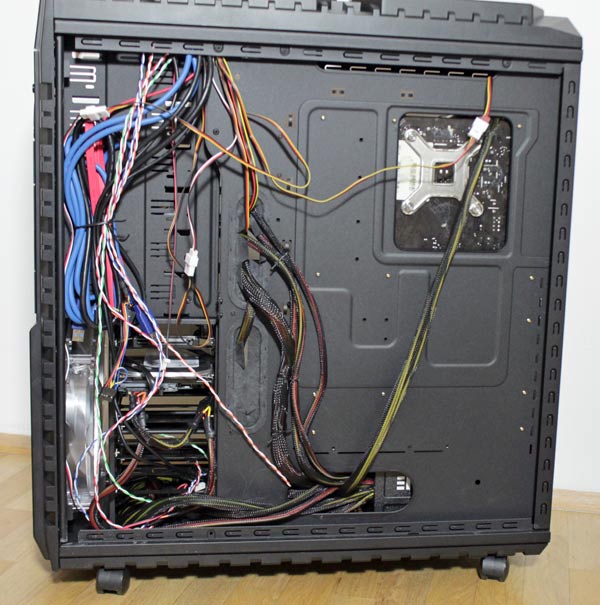
The brackets used for cable management are usually located around holes, and we’d really like to see them on more places around the case so that the cables can be fixed rather than piling up on certain spots. In fact, it gets pretty irritating when it won’t allow the side panel to close. 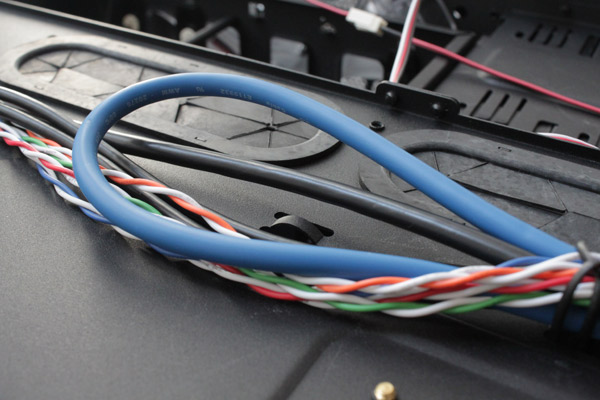
We’d very much like to see some of the newer cases to come with a special channel for all the cables. The following photo will drive our point further – the channel could run up to the blue cables, where you currently see two holes. Furthermore, a few “tying-points” wouldn’t hurt either. 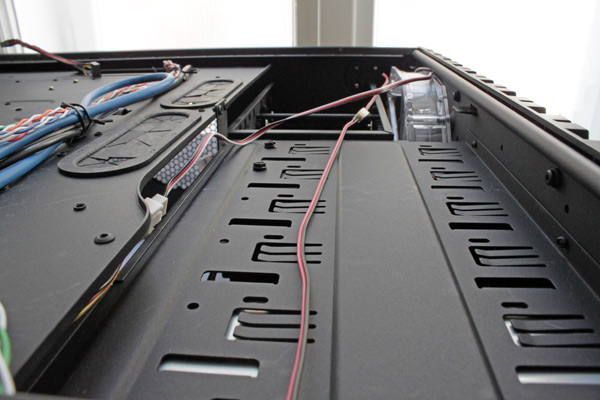
Of course, we’re paid to be nitpicky so don’t be discouraged – HAF X is in no way behind any of the high-end cases when it comes to cable management. We however didn’t bother much with aesthetics (as you can see from the photo below) so we were content to see the side panel close unhindered. 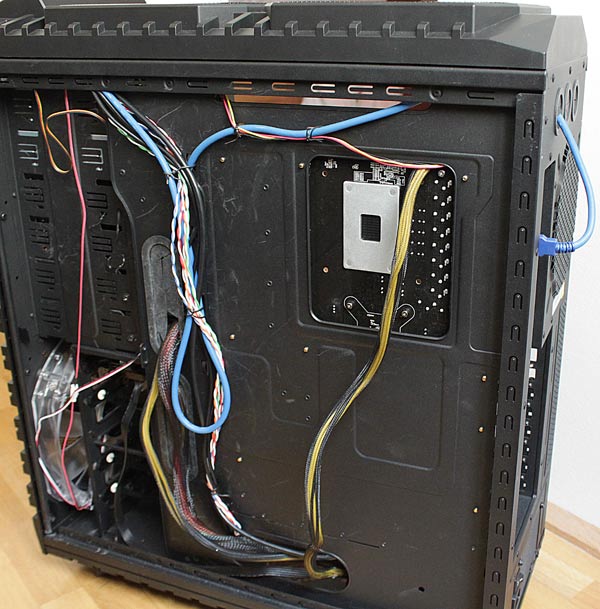
HAF X does offer something we haven’t seen on other cases – a special bracket that will hide the cables going from the PSU on the bottom of the case (picture below). The cables that you won’t route behind the motherboard can be arranged and hidden from sight. 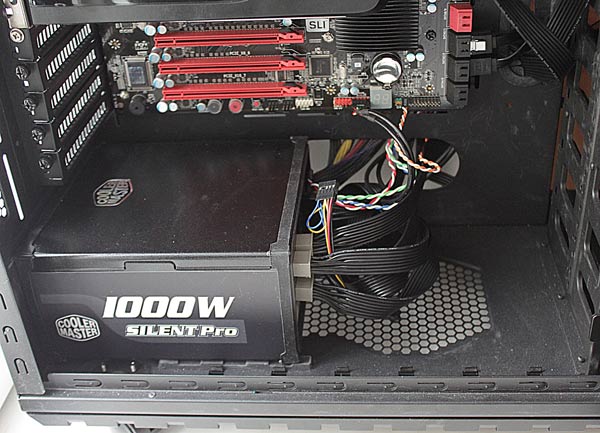
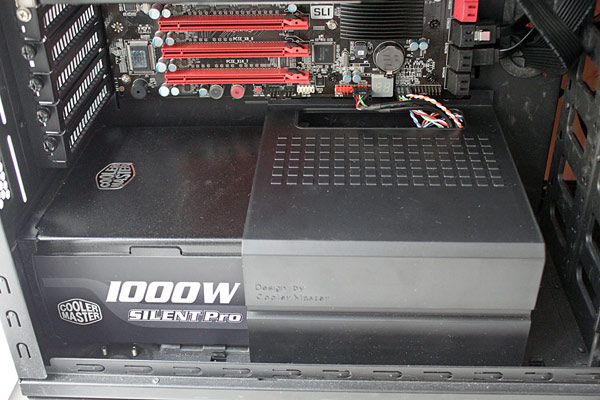
Are the fans loud? How efficient are they?
HAF X comes with four preinstalled fans which we controlled via Scythe’s KazeMaster ACE controllers. However, the fans are pretty quiet at maximum RPM so there was really no need to control them. All the fans have 3-pin connectors and the only thing we’d like to see are slightly longer cables.
Air intake is handled by two fans – 230 mm (700 RPM, 19dBA) on the front panel (bottom) and one 200 mm (700 RPM, 19dBA) on the side panel. Air outtake is also left to two fans – a 140 mm (1200 RPM, 19dBA) on the rear panel and a 200 mm fan (700 RPM, 19dBA) on the top panel.
Cooler Master made sure that HAF X is a worthy successor to the popular HAF 932 and it certainly is one of the best cases we've seen so far. HAF X is a full tower case with plenty of space and quiet yet very efficient cooling.
HAF X will definitely appeal to enthusiasts and hard core gamers alike and its features speak for itself. Quality cooling, compatibility with pretty much any motherboard and graphics card form factor, USB 3.0 connectors, hot-swappable drive bays, hot looks – HAF X has it all.
To demonstrate the fact that it has more room than you’ll probably ever need, we strapped it with our EVGA 4-Way Classified SLI motherboard and the former fit like a glove. Nine expansion slots on the rear panel allow for setting up to four video cards and four large but quiet fans will make sure cooling is top notch. Since this is a pretty hefty case, HAF X comes with wheels.
In conclusion, we definitely recommend HAF X as we’re talking about one of the best cases currently around, and you can find it priced at €165, here.
